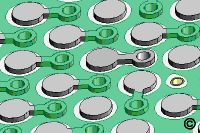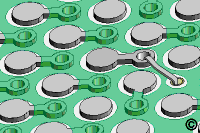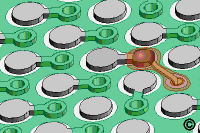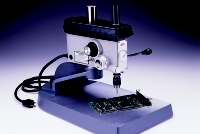No. 6.2.2
Jumper Wires, BGA Components, Through Board Method
OUTLINE
This method is used to add a jumper at a BGA site by running the jumper
through a hole in the board. This method is normally used for engineering
changes or modifications.
NOTE
This procedure requires precision milling equipment and highly trained
technicians. This method is used when there is a buried via, and other methods
of terminating to the opposite side are not an option.
TOOLS & MATERIALS
BGA Pad Repair Kit
Circuit Track
Cleaner
End Mills
Epoxy
Flux, Liquid
Knife
Microscope
Milling System
Oven
Precision Drill System
Scraper
Solder
Soldering Iron
Tape, Kapton
Teflon Sleeving
Tweezers
Wipes
PROCEDURE
- Clean the area.
- Remove the BGA component if installed, remove excess solder from the pads,
and clean and inspect the site.
- Remove solder mask from the via pad terminating to the subject BGA pad. Do
not remove any solder mask from the "dog bone" area.
- Mill a hole through the board at the precise coordinates using a Precision
Drill System and End Mill of the appropriate size. (See Figure 1 and 5).
NOTE
Although both power and ground planes may be cut, inner layer signal traces must
be avoided.
- Carefully inspect the milled hole and clean the area.
- Insert an appropriately sized Teflon sleeve into the milled hole. This
sleeve will insulate the new conductor and prevent shorting to the inner layers.
(See Figure 1).
- Select a Circuit Track to match the width of the circuit to be installed.
Cut a length approximately as needed. The overlap solder connection should be a
minimum of 2 times the circuit width. (See Table 1).
Table 1 - Common Circuit Track Sizes
| Part No. |
Thickness |
Width |
| 115-2504 |
.002" |
.004" |
| 115-5206 |
.002" |
.006" |
| 115-5208 |
.002" |
.008" |
| 115-5210 |
.002" |
.010" |
| 115-5312 |
.003" |
.120" |
| 115-5315 |
.003" |
.015" |
| 115-5520 |
.005" |
.020" |
| 115-5530 |
.005" |
.030" |
- Gently abrade the top and bottom of the new Circuit Track with the buffer to
remove any oxidation and clean.
NOTE
If needed, the ends of the Circuit Track may be tinned with solder prior to lap
soldering in place.
- Insert one end of the Circuit Track into the plated hole connected to the
BGA pad. Insert the opposite end through the Teflon sleeve. (See Figure 2).
- Apply a small amount of liquid flux and lap solder the Circuit Track to the
plated hole connected to the BGA pad using solder and a soldering iron. Make
sure the new circuit is properly aligned. (See Figure 3).
- Clean the area.
- Mix epoxy per procedure 2.7.
- Coat the top and sides of the new circuit with epoxy. The epoxy bonds the
new circuit to the base board material and insulates the circuit. (See Figure
4).
NOTE
Keep the epoxy height below the BGA pad level.
CAUTION
Some components may be sensitive to high temperature.
- Clean the board as required.
- Install new BGA per applicable procedures.
- Solder a jumper wire to the exposed Circuit Track on the opposite side of
the circuit board. Route and terminate the jumper wire as needed.
EVALUATION
- Visual examination for alignment and overlap of new circuit.
- Visual examination of epoxy coating for texture and color match.
- Electrical tests as applicable.
|
|
|
Solutions Across the Board
TM
|
|
|
|
Product Class: R/F/C
Skill Level: Expert
Conformance Level: High
Revision: B
Revision Date: Jul 7, 2000
Repair Service Charge

Figure 1: Mill a hole through the board and insert a Teflon sleeve.

Figure 2: Insert a copper Circuit Track into the plated hole and Teflon sleeve

Figure 3: Solder the Circuit Track to the plated hole connected to the BGA pad.

Figure 4: Overcoat the new connection with epoxy.

Figure 5: Precision Drill System used for milling the teflon sleeved hole.
|
Tricks of the Trade
A unique repair method pioneered at Circuit Technology Center.
Call for more information.
|
|
|






